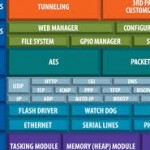 When I was getting my first taste of the computing industry back in the ’70s, most corporate customers bought “technology stacks” from a single vendor. I remember the DEC stack. You started at the bottom with the VAX — the machine itself. Then you added the operating system, VMS. On top of VMS — more or less in order — you added a file system (Files-11), a database (rdb), a network (DECnet), and maybe some applications (All-In-One). It all fit together rather nicely. Unfortunately, you also paid through the nose. Once you started building the stack, you could only buy the next layer from one vendor: DEC. You were locked in and ultimately paid whatever DEC wanted you to pay. All the vendors did it – IBM, Burroughs, UNIVAC, NCR, Control Data, Honeywell — so the only real competition was when you initially chose the stack.
When I was getting my first taste of the computing industry back in the ’70s, most corporate customers bought “technology stacks” from a single vendor. I remember the DEC stack. You started at the bottom with the VAX — the machine itself. Then you added the operating system, VMS. On top of VMS — more or less in order — you added a file system (Files-11), a database (rdb), a network (DECnet), and maybe some applications (All-In-One). It all fit together rather nicely. Unfortunately, you also paid through the nose. Once you started building the stack, you could only buy the next layer from one vendor: DEC. You were locked in and ultimately paid whatever DEC wanted you to pay. All the vendors did it – IBM, Burroughs, UNIVAC, NCR, Control Data, Honeywell — so the only real competition was when you initially chose the stack.
Buyers ultimately revolted and the industry shifted to “horizontal layers”. You bought a machine from one vendor, an operating system (often UNIX) from another, a database (Oracle, Informix, Ingres) from another, and applications (J.D. Edwards, Lawson) from still others. Competition existed at every layer of the stack and prices declined dramatically. Margins did too. Of all the vendors mentioned in the previous paragraph, only the strongest, IBM, survived.
The downside, of course, was a huge integration problem. The layers didn’t fit together neatly and they weren’t tuned for each other. Software services companies grew rapidly and every application vendor had its own service business as well. Implementing software was lucrative and complicated. I once worked for an applications company that required nine working days just to load the software!
Recent announcements from IBM and Oracle suggest that the stack is back. Both companies are offering systems that are pre-packaged with layers of software and utilities. The machines arrive on your premises almost ready to run. (It still takes a few hours — but not days or weeks or months). You can still choose which applications to run on the top of the stack — though I suspect Oracle will soon package its applications as the “solution” layer as well. IBM has fewer applications to put at the top of the stack which suggests that it may be in the market for additional third-party application vendors. IBM and Oracle may be the only two vendors currently capable of offering complete bottom-to-top stacks. HP doesn’t have the applications. SAP doesn’t have the hardware. Amazon doesn’t have either. So what does all this mean? Less business for software implementation/integration companies. Fewer independent enterprise application vendors. And a titanic battle between IBM and Oracle to control the next phase of the computing industry.
Recent Comments